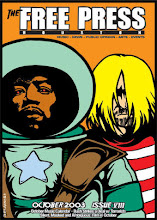He's In CONTROL
Talking with producer Orian Williams about the film Control, one thing becomes immediately apparent. We have a lot in common. Williams grew up in Houston, attended high school in Alief, read Public News and attended concerts as a teen at Numbers.
"I was working as an extra on the movie Tiger's Tale (shot in Houston in the mid-80s)," Williams tells Free Press Houston during a phoner. "I was talking with C. Thomas Howell at lunch and decided I wanted to work in movies." Subsequently Williams attended Baylor University in Waco then moved to the West Coast. Williams talks about his admiration for 80s rock groups like New Order and the Pixies, a crush that has come full circle with Control bringing the real life story of Ian Curtis, lead singer of Joy Division, to the screen.
Williams produced Shadow of the Vampire in 2000 and had also acquired the rights to Touching From A Distance, the biography of Ian Curtis as written by his wife Deborah.
Stories abound about how exactly Curtis offed himself. In the movie The Living End (1992) by Gregg Araki the lead characters describe Curtis death as suicide by hanging while standing on a melting block of ice. That was an early attempt at myth, while Control succeeds in putting a realistic spin on the film. Williams points out; "Curtis watched the Werner Herzog film Stroszek, which ends in suicide, and then listened to Iggy Pop's The Idiot before he hung himself in his apartment." Control uses the actual exterior of the flat and the street outside where Ian and Deborah lived in Macclesfield, a small village on the periphery of Manchester. When Curtis committed suicide in May of 1980 the remaining members formed New Order.
Director Anton Corbijn started as a rock photographer and in fact had taken a now famous picture of Joy Division descending a staircase to the subway.
"We met for a two-hour lunch, and he told me his story, about him relocating from Holland to London because of Joy Division," recalls Williams. "Then he took the iconic image of them descending down the tube station. A few months later, Ian killed himself. That photo suddenly became very important." Corbijn since established a reputation as a music vid helmer shooting videos for U2 and Depeche Mode.
"Secretly, I wanted him to direct it, as it would have been so cool with his connection to the band," offers Williams. "I didn't realize it was such a complete connection, until he told me his story of moving to the UK because of them. He soon echoed my realization and told me: You know what, I might be the only person to direct this movie. He didn't say it in an arrogant way, but in a manner that suggested he wanted to be the protector of the story," Williams explained.
Control was shot in color but digitally transferred to black and white. "We never even watched dailies in color, it was black and white from the beginning," says Williams. For the scene on Tony Wilson's show they considered switching to color. When they began to assemble edit that sequence they looked at it in color, and never went any further with that idea. As a finished film Control's black and white photography projects a tone and an attitude totally unlike current films or biopics. Control has been picked for North American distribution by the Weinstein Company who also has the other distinguished music biopic (also with some parts in black and white) I'm Not There.
Williams will attend and conduct a Q&A at the Angelika Film Center in Houston on Monday, November 12 at the 7:30 pm screening.









0 Comments:
Post a Comment
<< Home